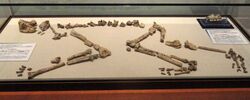Biology:Nacholapithecus
| Nacholapithecus | |
|---|---|

| |
| Nacholapithecus kerioi at the Kyoto University Museum | |
| Scientific classification | |
| Domain: | Eukaryota |
| Kingdom: | Animalia |
| Phylum: | Chordata |
| Class: | Mammalia |
| Order: | Primates |
| Suborder: | Haplorhini |
| Infraorder: | Simiiformes |
| Family: | †Proconsulidae |
| Genus: | †Nacholapithecus Ishida, Kunimatsu, Nakatsukasa & Nakano, 1999 |
| Species | |
| |
Nacholapithecus kerioi was an ape that lived 14-15 million years ago[1] during the Middle Miocene. Fossils have been found in the Nachola formation in northern Kenya. The only member of the genus Nacholapithecus, it is thought to be a key genus in early hominid evolution. Similar in body plan to Proconsul, it had a long vertebral column with six lumbar vertebrae, no tail, a narrow torso, large upper limbs with mobile shoulder joints, and long feet.[2]
Together with other Kenyapithecinae such as Equatorius, Kenyapithecus, and Griphopithecus, Nacholapithecus displayed synapomorphies with Anoiapithecus.[3]
Taxonomy
Nacholapithecus was initially classified as belonging in Kenyapithecus,[4] then attributed[5] to Equatorius (with Equatorius perhaps grouped into a subfamily Equatorinae, instead of both species in Afropithecini),[6][7] finally recognised by Ishida et al. (1999) as a separate genus.[8][9][10] Classified perhaps as a member of the family Proconsulidae.[11]
Fossil finds
Nacholapithecus kerioi is known from the lowest part of the Aka Aiteputh Formation, one of five formations in the Neogene System in Nachola, Samburu District, northern Kenya.[12][13] The formation is largely part of the north-western rift flank overlying the Nachola Formation.[14]
Notes
- ↑ Sawada et al. 2006
- ↑ Henke & Hardt 2007, p. 1020
- ↑ Moyà-Solà et al. 2009
- ↑ Ishida et al. 1984
- ↑ Ward et al. 1999
- ↑ Cameron 2004
- ↑ Cameron 2004, p. 101
- ↑ Ishida et al. 1999
- ↑ Russon & Begun 2004, p. 305
- ↑ Ishida et al. 2004, Abstract
- ↑ Zalmout et al. 2010
- ↑ Nakatsukasa & Kunimatsu 2009, Abstract
- ↑ Sawada et al. 2006
- ↑ Ishida et al. 2006, p. 74
References
- Cameron, D. W. (2004). Hominid Adaptations and Extinctions. UNSW Press. ISBN 9780868407166. https://books.google.com/books?id=fnqzb4_UVfkC&pg=PA101.
- Henke, W.; Hardt, T. (2007). Handbook of paleoanthropology. Springer. ISBN 978-3-540-32474-4. https://books.google.com/books?id=vhoRdbTrjc8C&pg=PA1020.
- Ishida, H.; Pichford, M.; Nakaya, H.; Nakano, Y. (1984). "Fossil anthropoids from Nachola and Samburu Hills, Samburu District, Kenya". African Study Monographs. Supplementary Issue 2 (2): 73–85. doi:10.14989/68314.
- Ishida, H.; Kunimatsu, Y.; Nakatsukasa, M.; Nakano, Y. (1999). "New hominoid genus from the Middle Miocene of Nachola, Kenya". Anthropological Science 107 (2): 189–191. doi:10.1537/ase.107.189.
- Ishida, H.; Kunimatsu, Y.; Takano, T.; Nakano, Y.; Nakatsukasa, M. (2004). "Nacholapithecus skeleton from the Middle Miocene of Kenya". Journal of Human Evolution 46 (1): 69–103. doi:10.1016/j.jhevol.2003.10.001. PMID 14698685.
- Ishida, H.; Tuttle, R.; Pickford, M.; Ogihara, N.; Nakatsukasa, M. (2006). Ishida, H.; Tuttle, R.; Pickford, M. et al.. eds. Human Origins and Environmental Backgrounds. Developments in Primatology: Progress and Prospects. Springer. ISBN 9780387296388. https://books.google.com/books?id=0KfjsoDXUtUC&pg=PA74.
- Moyà-Solà, S.; Alba, D. M.; Almécija, S.; Casanovas-Vilar, I.; Köhler, M.; de Esteban-Trivigno, S.; Robles, J. M.; Galindo, J. et al. (2009). "A unique Middle Miocene European hominoid and the origins of the great ape and human clade". PNAS 106 (24): 9601–06. doi:10.1073/pnas.0811730106. PMID 19487676. Bibcode: 2009PNAS..106.9601M.
- Nakatsukasa, M.; Kunimatsu, Y. (May–June 2009). "Nacholapithecus and its importance for understanding hominoid evolution". Evolutionary Anthropology 18 (3): 103–119. doi:10.1002/evan.20208.
- Russon, A. E.; Begun, D. R. (2004). Russon, A. E.; Begun, D. R.. eds. The Evolution of Thought: Evolutionary Origins of Great Ape Intelligence. Cambridge University Press. ISBN 9780521783354. https://books.google.com/books?id=DvV-WJHWcTsC&pg=PA305.
- Sawada, Y.; Saneyoshi, M.; Nakayama, K.; Sakai, T.; Itaya, T.; Hyodo, M.; Mukokya, Y.; Pickford, M. et al. (2006). "The Ages and Geological Backgrounds of Miocene Hominoids Nacholapithecus, Samburupithecus, and Orrorin from Kenya". Human Origins and Environmental Backgrounds. Developments in Primatology: Progress and Prospects. Springer. pp. 71–96. doi:10.1007/0-387-29798-7_6. ISBN 978-0-387-29638-8.
- Ward, S.; Brown, B.; Hill, A.; Kelley, J.; Downs, W. (1999). "Equatorius: A new hominoid genus from the middle Miocene of Kenya". Science 285 (5432): 1382–1386. doi:10.1126/science.285.5432.1382. PMID 10464093.
- Zalmout, I. S.; Sanders, W. J.; MacLatchy, L. M.; Gunnell, G. F.; Al-Mufarreh, Y. A.; Ali, M. A.; Nasser, A.-A. H.; Al-Masari, A. M. et al. (2010). "New Oligocene primate from Saudi Arabia and the divergence of apes and Old World monkeys". Nature 466 (7304): 360–364. doi:10.1038/nature09094. PMID 20631798. Bibcode: 2010Natur.466..360Z.
Wikidata ☰ Q5237039 entry
 |

